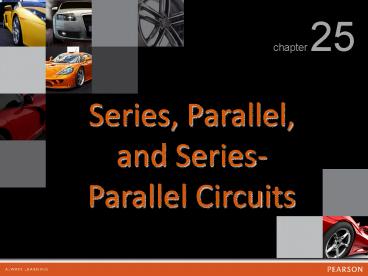Series, Parallel, and Series- Parallel Circuits - PowerPoint PPT Presentation
1 / 30
Title:
Series, Parallel, and Series- Parallel Circuits
Description:
... each resistance has power and ground and each leg operates ... FIGURE 25.24 This complete headlight circuit with all bulbs and switches is a series ... – PowerPoint PPT presentation
Number of Views:540
Avg rating:3.0/5.0
Title: Series, Parallel, and Series- Parallel Circuits
1
Series, Parallel,and Series-Parallel Circuits
chapter 25
2
FIGURE 25.1 A series circuit with three bulbs.
All current flows through all resistances
(bulbs). The total resistance of the circuit is
the sum of the total resistance of the bulbs, and
the bulbs will light dimly because of the
increased resistance and the reduction of current
flow (amperes)through the circuit.
3
FIGURE 25.2 A series circuit with two bulbs.
4
FIGURE 25.3 As current flows through a circuit,
the voltage drops in proportion to the amount of
resistance in the circuit. Most, if not all, of
the resistance should occur across the load such
as the bulb in this circuit. All of the other
components and wiring should produce little, if
any, voltage drop. If a wire or connection did
cause a voltage drop, less voltage would be
available to light the bulb and the bulb would be
dimmer than normal.
5
FIGURE 25.4 In a series circuit the voltage is
dropped or lowered by each resistance in the
circuit. The higher the resistance, the greater
the drop in voltage.
6
FIGURE 25.5 A voltmeter reads the differences of
voltage between the test leads. The voltage read
across a resistance is the voltage drop that
occurs when current flows through a resistance. A
voltage drop is also called an IR drop because
it is calculated by multiplying the current (I)
through the resistance (electrical load) by the
value of the resistance (R).
7
FIGURE 25.6 In this series circuit with a 2-ohm
resistor and a 4-ohm resistor, current (2
amperes) is the same throughout even though the
voltage drops across each resistor.
8
FIGURE 25.7 Example 1.
9
FIGURE 25.8 Example 2
10
FIGURE 25.9 Example 3
11
FIGURE 25.10 Example 4
12
FIGURE 25.11 The amount of current flowing into
junction point A equals the total amount of
current flowing out of the junction.
13
FIGURE 25.12 The current in a parallel circuit
splits (divides) according to the resistance in
each branch.
14
FIGURE 25.13 In a typical parallel circuit, each
resistance has power and ground and each leg
operates independently of the other legs of the
circuit
15
FIGURE 25.14 A schematic showing two resistors in
parallel connected to a 12-volt battery.
16
FIGURE 25.15 A parallel circuit with three
resistors connected to a 12-volt battery.
17
FIGURE 25.16 Using an electronic calculator to
determine the total resistance of a parallel
circuit.
18
FIGURE 25.17 Another example of how to use an
electronic calculator to determine the total
resistance of a parallel circuit. The answer is
13.45 ohms. Notice that the effective resistance
of this circuit is less than the resistance of
the lowest branch (20 ohms).
19
FIGURE 25.18 A parallel circuit containing four
12-ohm resistors. When a circuit has more than
one resistor of equal value, the total resistance
can be determined by simply dividing the value of
the resistance (12 ohms in this example) by the
number of equal-value resistors (4 in this
example) to get 3 ohms.
20
FIGURE 25.19 Example 1.
21
FIGURE 25.20 Example 2
22
FIGURE 25.21 Example 3
23
FIGURE 25.22 Example 4
24
FIGURE 25.23 A series-parallel circuit.
25
FIGURE 25.24 This complete headlight circuit with
all bulbs and switches is a series-parallel
circuit.
26
FIGURE 25.25 Solving a series-parallel circuit
problem
27
FIGURE 25.26 Example 1.
28
FIGURE 25.27 Example 2
29
FIGURE 25.28 Example 3
30
FIGURE 25.29 Example 4































